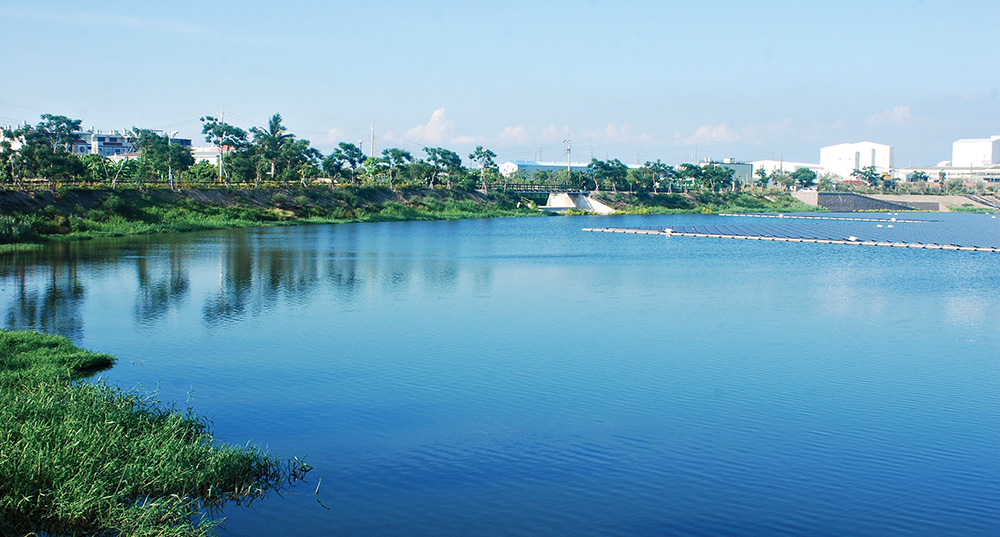Enchanting Yongan District
Enchanting Yongan District
◎Written by Yu Jia-rong
◎English translation by Hou Ya-ting
◎Photos by Yu Jia-rong
Yongan District is a true example of the region's maritime culture. It is known for its once prosperous salt farms and aquaculture industries. The locals have grown accustomed to making a living from the sea and are always warm and welcoming to visitors.
Yongan Wetlands Park's scenic mangrove forest is one of its most popular attractions. Visitors can also check out the red-brick roofed historical houses and tour its fishing farms. According to Yongan District's offical website, Yongan literally means perpetual peace and safety. The region offers a mixture of traditional and modern, with attractions that include the Yongan Flood Detention Area, Tianwun Temple and Weisin Village's colorful paintings.

Yongan Flood Detention Area
Yongan District is situated in low terrain, so it is at high risk for floods. In 2006, the Water Resources Bureau developed a number of flood prevention initiatives, including the Yongan Flood Detention Area. It covers 9.5 hectares and has a capacity for 17 thousand tons of overflow, and it usually stores about 50 centimeters of groundwater.
The detention area was designed to be ecologically friendly. Various plants surround it to prevent soil erosion; several water birds, amphibious animals and reptiles have made it their home. It also has floating solar panels so that the facility can continue to operate through typhoons, earthquakes and torrential rains.
Tianwun Temple
 Tianwun Temple is a wonderful place to watch the local people worship. When visitors come, residents enjoy sharing about its history and legends. It is devoted to the deity, King Syu Ciansuei (Syu Shih-ji), who was a prestigious Tang Dynasty general that served three emperors throughout his career. In the Taoist religion legendary people who made significant contributions become deities after they have passed away. When King Syu Ciansuei passed away, the celestial emperor, Yu Huang Dadi, is Taoism's Supreme Heavenly Ruler and appointed him to be the king to guard the human world. Legend has it that King Syu Ciansuei was first assigned as a deity governor under Yu Huang Dadi's direction to serve in Sia Jinluan Temple in Cieding District.
Tianwun Temple is a wonderful place to watch the local people worship. When visitors come, residents enjoy sharing about its history and legends. It is devoted to the deity, King Syu Ciansuei (Syu Shih-ji), who was a prestigious Tang Dynasty general that served three emperors throughout his career. In the Taoist religion legendary people who made significant contributions become deities after they have passed away. When King Syu Ciansuei passed away, the celestial emperor, Yu Huang Dadi, is Taoism's Supreme Heavenly Ruler and appointed him to be the king to guard the human world. Legend has it that King Syu Ciansuei was first assigned as a deity governor under Yu Huang Dadi's direction to serve in Sia Jinluan Temple in Cieding District.
Medium Guo Wu-jhen was appointed to assist King Syu Ciansuei in communicating with local residents. As King Syu Ciansuei served more people, he gained more followers. As these numbers increased, King Syu Ciansuei devoted himself to this service in Tianwun Temple, located in Yongan District's Jhuzih Harbor. Transportation was inconvenient for Yongan followers at that time, so Tianwun Temple was opened and licensed in 1952. It was rebuilt by renowned Taiwanese temple architect, Mr. Siao Wan-sheng, in 1983.
Statues of the general on a horse can be seen on both the left and right sides of the temple courtyard. This is symbolic of the deity's readiness to be of service for the people. Tianwun Temple has neither Door Gods Cin Shu-bao nor Wei Chih-gong painted on the main doors since they were also famous Tang Dynasty generals and King Syu Ciansuei's peers. Instead, there are 108 metal balls on the main door, representing the 108 celestial temple guards that are responsible for annihilating evil spirits and demons. There is also a decorative wooden carving ceiling, beautiful Chinese calligraphy and an elegant Chinese garden, in and around the temple.
Weisin Village's colorful paintings
Weisin Village has numerous colorful paintings of various topics, including sharks, puppies, groupers and egrets. The collaboration project that brought together both professional artists and local residents was developed by Village Chief Mr. Jian Fu-shan. The paintings truly bring the neighborhoods to life. Visitors often come to take a wander around and enjoy the delightful artwork.
